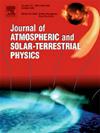Is heating of ions by Alfvén waves via nonresonant interactions applicable in the Earth’s magnetosphere?
IF 1.8
4区 地球科学
Q3 GEOCHEMISTRY & GEOPHYSICS
Journal of Atmospheric and Solar-Terrestrial Physics
Pub Date : 2025-02-01
DOI:10.1016/j.jastp.2024.106413
引用次数: 0
Abstract
Heating of ions in Earth’s magnetosphere by enhanced Alfvn waves below resonance frequency (nonresonant heating) has been presented in many studies, among these is the study of Wang et al. (2006) in which they stated that in any region in space with low beta plasma, this heating process, i.e. nonresonant ion heating is applicable and effective. In this paper we stress on the inapplicability of this type of heating in the Earth’s magnetosphere. We present; (1) a data set that provides a strong proof that the theory presented by Wang et al. (2006) is not applicable in this region of space (i.e. Earth’s magnetosphere), (2) in addition, we plot altitude profiles for parallel, perpendicular, and total temperatures for hydrogen ions in cusp and central polar cap regions by evaluating observed magnetic activity and Alfvn waves into Wang et al. (2006) theory, we find the changes in the altitude behavior in ion temperature profiles are very small, (3) also, we compare between Monte Carlo simulations results of ion temperatures obtained by using Barghouthi model (this model includes the effects of gravity, polarization electric field, divergence geomagnetic field, centrifugal acceleration, resonant ion heating, and with and without nonresonant ion heating effect) in cusp and central polar cap regions with appropriate boundary conditions (Barghouthi et al., 2008), both simulation results of ion temperatures are almost the same. Therefore, we report on the nonresonant ion heating process in central polar cap and cusp regions is not significant.
在地球的磁层中,通过非共振的相互作用,阿尔夫萨芬波对离子的加热是否适用?
许多研究都提出了通过低于共振频率的增强alfvsamn波加热地球磁层中的离子(非共振加热),其中包括Wang等人(2006)的研究,他们在研究中指出,在空间中具有低β等离子体的任何区域,这种加热过程,即非共振离子加热都是适用和有效的。在本文中,我们强调这种加热在地球磁层中的不适用性。我们现在;(1)一个数据集,它提供了一个强有力的证明了王et al .(2006)提出的理论不适用在这个区域的空间(即地球的磁气圈),(2)此外,我们为平行的情节高度资料,垂直,温度和总氢离子极冠尖端和中部地区通过评估观察磁场活动和阿尔芬波王et al。(2006)理论,我们发现在离子温度高度的变化行为概要文件非常小,(3)在适当的边界条件下,比较了Barghouthi模型(该模型包括重力、极化电场、发散地磁场、离心加速度、共振离子加热以及有无共振离子加热效应的影响)在尖极区和中极帽区离子温度的蒙特卡罗模拟结果(Barghouthi et al., 2008),两者的离子温度模拟结果基本相同。因此,我们报道的非共振离子加热过程在中心极帽和尖峰区域是不显著的。
本文章由计算机程序翻译,如有差异,请以英文原文为准。
求助全文
约1分钟内获得全文
求助全文
来源期刊

Journal of Atmospheric and Solar-Terrestrial Physics
地学-地球化学与地球物理
CiteScore
4.10
自引率
5.30%
发文量
95
审稿时长
6 months
期刊介绍:
The Journal of Atmospheric and Solar-Terrestrial Physics (JASTP) is an international journal concerned with the inter-disciplinary science of the Earth''s atmospheric and space environment, especially the highly varied and highly variable physical phenomena that occur in this natural laboratory and the processes that couple them.
The journal covers the physical processes operating in the troposphere, stratosphere, mesosphere, thermosphere, ionosphere, magnetosphere, the Sun, interplanetary medium, and heliosphere. Phenomena occurring in other "spheres", solar influences on climate, and supporting laboratory measurements are also considered. The journal deals especially with the coupling between the different regions.
Solar flares, coronal mass ejections, and other energetic events on the Sun create interesting and important perturbations in the near-Earth space environment. The physics of such "space weather" is central to the Journal of Atmospheric and Solar-Terrestrial Physics and the journal welcomes papers that lead in the direction of a predictive understanding of the coupled system. Regarding the upper atmosphere, the subjects of aeronomy, geomagnetism and geoelectricity, auroral phenomena, radio wave propagation, and plasma instabilities, are examples within the broad field of solar-terrestrial physics which emphasise the energy exchange between the solar wind, the magnetospheric and ionospheric plasmas, and the neutral gas. In the lower atmosphere, topics covered range from mesoscale to global scale dynamics, to atmospheric electricity, lightning and its effects, and to anthropogenic changes.
 求助内容:
求助内容: 应助结果提醒方式:
应助结果提醒方式:


